Filter well: design, purpose, device technology
Unlike residents of multi-storey buildings, owners of private households are not provided with a centralized sewage system and are forced to independently organize wastewater disposal at their site. An important role in the sewer and drainage system of the house is played by the filtering well.
However, it can not be installed everywhere, there are certain rules that must be followed when erecting it.
In our material, we will understand the types of filter wells, the rules for their installation on the site, and also talk about how to independently make such a structure.
The content of the article:
Purpose and features of filtration wells
Issues of ecology and environmental protection are very acute today. Untreated wastewater, if it enters directly into bodies of water or soil from a domestic sewage system, can be a source of water and soil contamination.
Therefore, this is strictly prohibited. Before entering open sources or entering the ground, dirty household water must pass through a treatment system.
Various methods of wastewater treatment are provided, one of which is an absorption well, which acts as a kind of natural multilayer filter. It retains dirt, debris and other particles, and allows purified water to enter the soil.
A distinctive feature of filtering structures is the lack of a sealed bottom. At the bottom of the well, a bottom filter of crushed stone, gravel, broken brick and other similar building materials is equipped. The total height of the filter bed should be up to one meter.
The filtering well is usually equipped in areas that are not equipped with a drainage system, as well as in places where there are no natural reservoirs nearby for water drainage.
It can be used as an independent structure for the arrangement of a drainage system or storm sewer, or for the purification of wastewater that has been pre-treated in a septic tank.
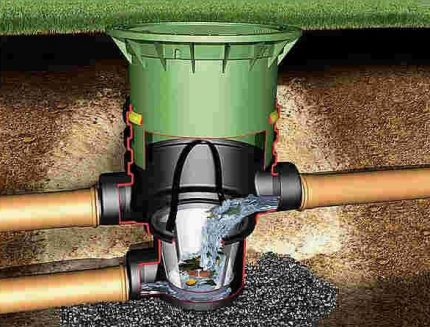
Rules and regulations for installation
The possibilities of filtration wells are very limited, the rules and features of their installation are regulated by building codes (SNiP behind number 2.04.03-85).
They can be installed only on certain types of soil: sandy or sandy loam, which in themselves have good absorption capacity. Absorption-type wells are not suitable for clay soils with low filtration properties.
For comparison, if 1 m² of medium-sized sand is capable of absorbing up to 80 liters of liquid per day, and sandy loam - up to 40, the absorbing capacity of loam - 25, and fractured clay - only 5 liters. From the above data it follows that when installing a filtration well on clay soil, it, of course, will purify the water, but it will have nowhere to go.
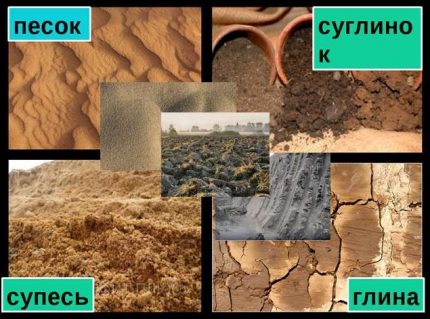
To find out the type of soil on the site, do the following experiment: Dig a small hole 300x300 mm in size and about 150 mm deep. Pour liquid into it to the very top and detect for how long the water will go underground. 18 seconds - sandy soil, half a minute - sandy loam, 2 minutes - loam.
Particular attention should be paid to the groundwater level in the area. If groundwater passes high enough, it is not recommended to install an absorption well, since its depth should be 2-2.5 m. At the same time, it is necessary to ensure a distance of at least one and a half meters from its bottom to groundwater.
Installation restrictions also apply to the average daily volume of wastewater. Their number should not exceed 1 m3. If the volume of effluents to be treated is greater, it is recommended that you select a different filtration and fluid drainage system.

If the water running underground is used for drinking or household needs, the arrangement of the well must be agreed with the sanitary and epidemiological surveillance services. But in any case, it must be done at a distance of at least 30 meters from wells and wells for drinking water. You can read about the features of installing a sewer pipeline on a site in this article.
Building regulations stipulate the rules governing the location of the conditional bottom of the filtering well. It must be above the groundwater horizon by 1.5 m or more.
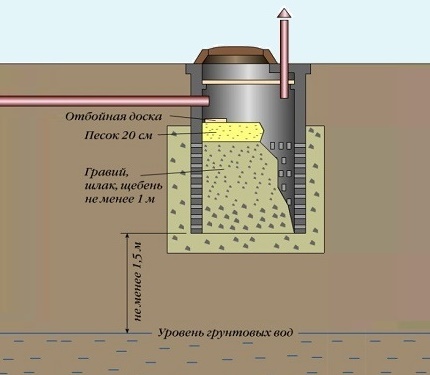
Types of filtering facilities
There are two types of well filtration facilities, working on the same principle and installed in a similar way. Their differences are in scope. The former are used in drainage and stormwater systems, the latter in sewer systems.
Absorption well in the drainage system
In this case, drainage absorbing wells are the end point of a complex system. site drainagewhere ground or rainwater rushes through the pipeline, so that later, after passing through a natural filter, go into the ground. Its main purpose is to divert water from the house and clean it from silt and sand.
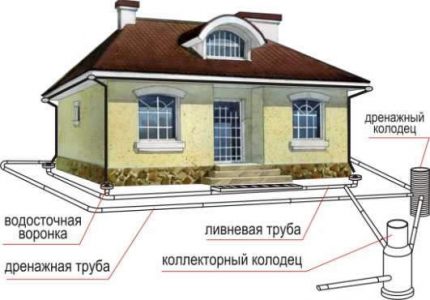
The diameter of such wells, as a rule, is not more than one and a half, and the depth to two meters. It is allowed to drain both systems into one well. The filter tank is installed at the lowest point of the site so that the water flows into it by natural gravity.
Filtration plant in the sewer system
In the sewer system of the site, absorption wells are used for the post-treatment of wastewater coming from a hermetically sealed tank, in which the wastewater undergoes primary biological treatment. The tank is made of concrete rings, brick or rubble stone, or a ready-made septic tank is used.

The principle of operation of the system is as follows: effluents from the house sewer enter a sealed container, where they oxidize within two to three days under the influence of anaerobic bacteria living in an airless space.
Then the wastewater enters the filtration well, where other bacteria - aerobes - are already present. Their vital activity is activated under the influence of oxygen.
As a result of double cleaning, the liquid entering the soil from the absorption well almost completely eliminates harmful microorganisms and organic substances.
Sewage can be arranged in two ways:
- Separate. Water from the kitchen, bathtub, washing machines enters the septic tank, and sewage with feces - into the cesspool.
- A joint. All domestic wastewater goes to septic tank or storage capacity.
As a rule, in the first case, gray effluents are directed to different sewage systems. For example, feces - into a collection well with subsequent pumping and removal, gray household drains from kitchen sinks, bathtubs, wash basins, etc. instruments - in absorption wells.
In the second case, a septic tank consisting of a minimum is required from two chambers, in each of which its own stage of cleaning is carried out sequentially. Fecal masses settle in the first chamber, from where they are periodically pumped out with a sewage machine.
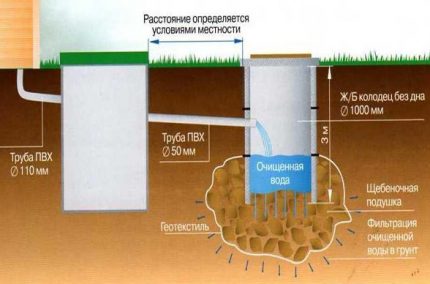
The second chamber receives liquid waste without suspended particles with a minimum amount of impurity, where they are further purified. After that, the water passes through pipes into the filtration well, from where, after passing through a natural filter, it goes into the soil.
The second version of the joint scheme is the complete pumping and removal of effluents.
Calculation of the number of filter wells in the area
The number of filtration wells depends on the daily water consumption in the house. Two to four absorption wells are usually installed on one septic tank. In turn, the volume of the septic tank should be three times the daily consumption of water effluents.
Based on the fact that for one person in a private house there are 250 liters per day, then for four family members you need a septic tank with a volume of at least 3 cubic meters. meters.
Load per 1 sq. m. the area of the absorption well is calculated based on the type of soil. (sand - up to 80, super sand - up to 40 l) If the distance from groundwater to the bottom of the well is more than two meters, the load can be increased by 20%. It is also permissible to increase the load in summer cottages, where the well is used only in the summer.
Alternative filter systems
In addition to the filtration well, aerobic tertiary treatment of wastewater in vivo can be done using:
- soil drainage;
- filtering trenches;
- biological filter.
In the first case, the wastewater from the septic tank first enters the distribution well, and then is distributed through drains - pipes with slots laid with a slope in the trenches, previously covered with gravel or rubble. From above the pipes are also sprinkled with rubble, then with earth and covered with geo-fabric. Read more about how to correctly calculate the slope of the drainage pipe. in this article.

If there is a reservoir near the site where purified water can flow, then filter trenches will be equipped. In the lower layer, drainage pipes are laid on the gravel cushion, which are then covered with gravel and sand. Lay on top of a layer of gravel drainage pipes with slots, cover them with geotextile and cover with earth.
If it is not possible to organize filter fields in the area, install a biofilter. It receives pre-treated water from a septic tank for further biological treatment. As a result of filtration, the effluents are treated to the level of industrial water, which then goes into the ground.
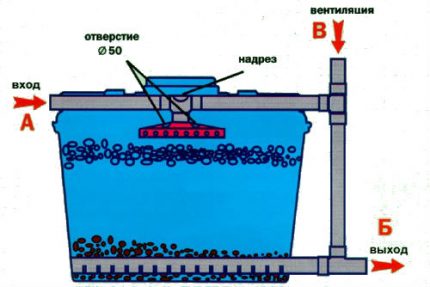
How to make a filtration well
Absorption wells can be built from burnt brick or rubble stone, but its construction requires considerable effort. Therefore, more often the walls of the well are made of reinforced concrete rings. Today, plastic structures are also widely used. You can make them yourself from plastic pipes or buy ready-made ones.
Option No. 1 - brick construction
The brick structure can be either round or square. Usually build round wells, which are the most convenient to use. The construction for filtering sewage should be deepened into the ground by 2.5 meters, with a diameter of not more than 2 x 2 meters.
The pit is dug in such a way that between the earth and the outer walls of the well there will be a layer of rubble, gravel or broken brick up to 40 cm thick. The height of the backfill is one meter. Walls at the filter level must be permeable.
To do this, the masonry to a height of one meter is not continuous, but with small holes ranging in size from 2 to 5 cm. They must be staggered. After the construction of the structure, crushed stone or gravel is poured into the cracks.
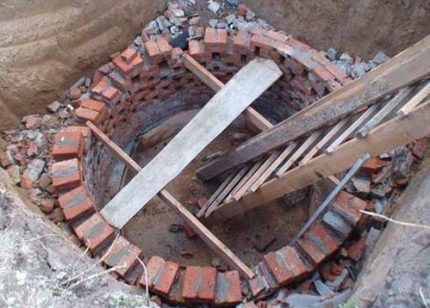
At the bottom of the structure, filling the filter layer from crushed stone or gravel to a height of one meter is carried out. At the same time, large fractions of the material are located below, small ones - from above. The hole for the pipe through which sewage from the septic tank will flow is made in such a way that the water pours from a height of 40-60 cm.
In the place where the water flows, it is necessary to lay a plastic sheet to prevent erosion of the filter. From above, the structure is closed with a lid or hatch with a diameter of 70 cm. Also, in the well, it is necessary to make a ventilation pipe with a cross section of 10 cm. It should rise 50-70 cm above the ground.
You will find step-by-step instructions for the construction of a brick drain pit in this material.
Option number 2 - the construction of concrete rings
For the construction of a filtration well, three reinforced concrete rings will be needed. One of them should have holes with a diameter of about 5 cm. You can buy a ring with perforation or make holes with a crown on concrete. You also need to make a hole for the inlet pipe.
It is necessary to dig a pit, the width of which is 40 cm more than the diameter of the ring. A perforated ring is installed at the bottom of the structure. You can not dig a hole, but only slightly deepen the platform on which the well is supposed to be made.
Put the first ring on the ground and select the ground from the inside. Gradually, it will fall down under the weight of its weight. Two upper rings are installed in the same way.
After that, you need to make a bottom filter of crushed stone or gravel up to one meter high and fill the outer walls of the well with the same material to the level of the filter layer. The hatch and ventilation pipe are installed in the same way as in a brick well.
Another option for arranging a septic tank from concrete rings can be read here.
Option number 3 - a well from old tires
The cheapest way to make a filter well is to make it from used tires. Such a design can provide filtering of sewage from a family of three. Basically, such a well is made in summer cottages, since in winter the rubber freezes and the vital activity of bacteria slows down, and even stops at very low temperatures.
The well is made very simply - the tires are installed one on top of the other and fastened together with plastic clamps. Joints are coated with sealant. All other structural elements are made in the same order as in wells made of other materials.

Option No. 4 - plastic filtering containers
Today you can buy ready-made filter wells made of plastic, equipped with everything necessary for the effective treatment of effluents. Of course, they cost a lot, but they are reliable, convenient, easy to install and maintain. There are many manufacturers of such equipment on the market.
For example, the Russian company POLEX-FC, whose products received good consumer ratings. Filter wells are produced in different volumes (from 1200x1500 to 2000x3000 mm), which allows you to choose a product based on the daily water consumption in an individual farm.
Tanks are made of corrosion-resistant durable plastic, the walls of the shaft are made of primary polyethylene. The lower compartment of the tank is covered with biofilm and is filled with a filter layer of crushed stone, gravel and slag.
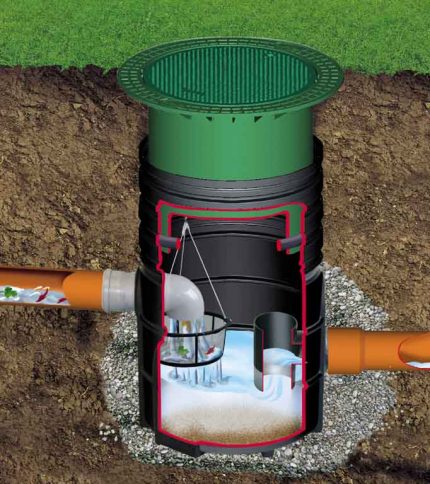
Conclusions and useful video on the topic
Watch the video and learn how to build a brick well:
Concrete construction video:
You will learn how to make a well out of old tires from the following video:
Filtering facilities perform a very important function - they provide effective wastewater treatment and do not allow dirty untreated water to enter the ground, which, when it enters the soil, causes significant harm to the environment.
A filtration well is not so difficult to do on your own, but if you do not want to mess with its arrangement and you have the financial ability, you can buy a ready-made well made of plastic.
If during the study of the material you had questions about the independent arrangement of filtration facilities, you can ask them in the comments section. There you can share the experience of arranging filter wells.

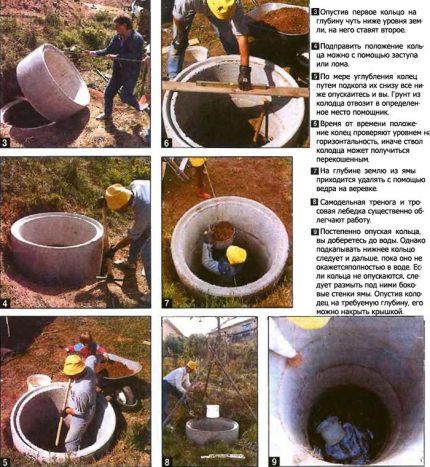
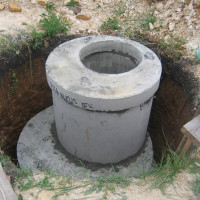 How to make a sewer well: do-it-yourself installation and installation
How to make a sewer well: do-it-yourself installation and installation 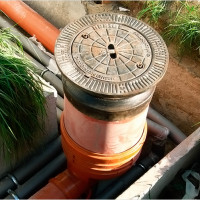 How to make a drainage well with your own hands and bring pipes to it
How to make a drainage well with your own hands and bring pipes to it  Manhole for sewage: installation of a well in storm and sewage systems
Manhole for sewage: installation of a well in storm and sewage systems  Drainage in a private house: device methods, schemes + main stages of construction
Drainage in a private house: device methods, schemes + main stages of construction 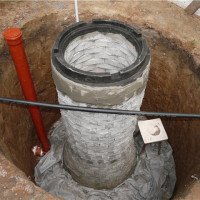 How and what is the waterproofing of sewer wells
How and what is the waterproofing of sewer wells 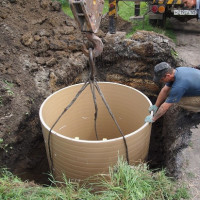 Viewing wells for drainage: types, arrangement and installation features
Viewing wells for drainage: types, arrangement and installation features  How much does it cost to connect gas to a private house: the price of organizing gas supply
How much does it cost to connect gas to a private house: the price of organizing gas supply  The best washing machines with dryer: model rating and customer tips
The best washing machines with dryer: model rating and customer tips  What is the color temperature of light and the nuances of choosing the temperature of the lamps to suit your needs
What is the color temperature of light and the nuances of choosing the temperature of the lamps to suit your needs  Replacement of a geyser in an apartment: replacement paperwork + basic norms and requirements
Replacement of a geyser in an apartment: replacement paperwork + basic norms and requirements
For the first time I hear that such a thing exists. When I built the house 3 years ago, the workers said that the water was centralized, but there was no sewage. Right next to the house, a few meters away, they dug a rather deep and large pit for draining, covered it with brick, covered it with a very dense concrete cover. Tell me, is it better for me to leave everything as it is or install a filter well?
Lina, you already have a filter well. A filter well is a structure without a bottom, when the water itself gradually leaves.
Recently acquired a country house, I really want to solve the problem with wastewater. The water supply was arranged both in the house and on the street, but the sewage facilities, without which it is impossible to use the water supply network, are still missing. Therefore, I’m thinking what to do better: a drive with pumping out all the drains or a septic tank with a filtering well. Tell me, at what distance should the filter well be placed from the well with drinking water and the house itself to avoid getting into the aquifer.
Good afternoon, Igor. If possible, it is better to equip the discharge of treated effluents into the ditch.
If this is not possible, the filtration well is located 12 meters from the foundation and 50 meters from the well with drinking water.In this case, the well should be 8-10 meters away from the septic tank. Please note that the minimum distance of the septic tank from the foundation is 3-5 meters, from the well the same 50 meters.
Igor, just not pumping out all the drains (when the system is completely tight) - you get tired of calling the pumping machine all the time (and it's not free)
Calculate that a person needs about 160 liters of water per day. Multiply by 30 days and get 4800 liters, this is 4.8 cubic meters per month for ONE person! This is the volume of a standard machine. Multiply by the number of people and the cost of the flight asinezator =).
Unambiguously make systems with two wells - the main (with the bottom) and overflow in the filter (without the bottom). In this case, if the filtering ability of the soil is sufficient (sand), pumping out water may not be necessary at all (only a suction pump to remove insoluble sediment - silt from the bottom of the well as it accumulates, i.e. very very rarely). Or, if the filtering ability of the soil is small, you will have to call the scavenger machine, but MUCH less often than if there were no filtering well.